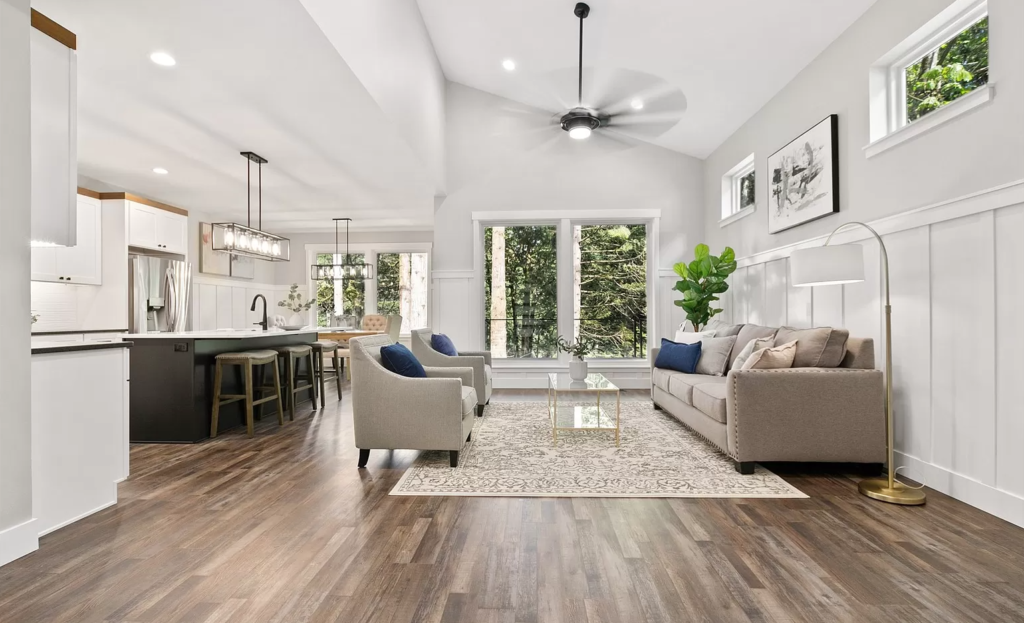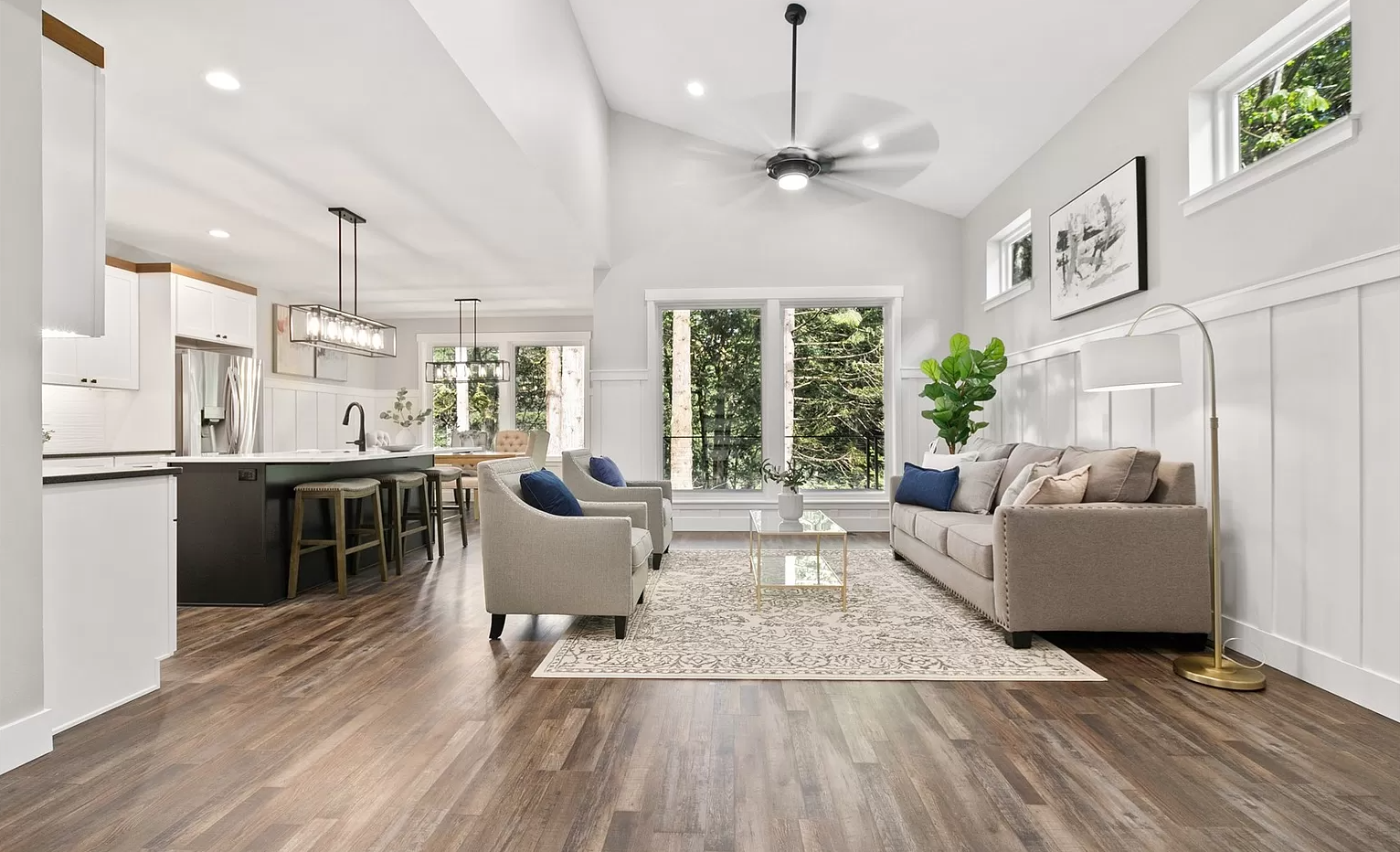Choosing flooring for your home or office can be overwhelming. Vinyl plank flooring (VPF) has become one of the most common options. Its low cost, versatility and easy-to-maintain nature has meant it remains a goto choice for homeowners. But is VPF the holy grail of flooring, or does it have its own inherent disadvantages?
If you’ve been thinking about vinyl plank flooring, you need to look past the shiny marketing brochures and examine the disadvantages of vinyl plank flooring.
What is Vinyl Plank Flooring?
Vinyl plank flooring is a synthetic floor covering made mainly from polyvinyl chloride (PVC). It looks like natural materials such as hardwood or stone, so it can be a good option if you want something aesthetically pleasing but have a limited budget.
What is Vinyl Plank Flooring Made of?
- The layers of vinyl plank flooring are generally as follows:
- Wear Layer A clear protective surface resistant to scratches and stains.
- The layer that gives the realistic look of wood, stone, or tile.
Core Layer: The inner layer that is usually a hard PVC or composite material, such as WPC (Wood-Plastic Composite) or SPC (Stone-Plastic Composite).
Backing Layer: A foundational layer that provides stability and sometimes includes padding for sound insulation.
Types of Vinyl Plank Flooring
- There are different types of vinyl plank flooring:
- Rigid Core: Durability and resistance to wear.
- WPC (Wood-Plastic Composite): Softer & More Comfortable Underfoot.
- Pros Of SPC (Stone-Plastic Composite): The most durable and dent-resistant.
Vinyl plank flooring is widely loved for its affordability, water resistance, and ease of installation, but as with any material, it’s important to also be aware of its disadvantages, which we’ll cover in detail below.
Susceptibility to Scratches
The top drawback of vinyl plank flooring is its susceptibility to scratches. Even though the wear layer offers some protection, it is not impervious.
- What Makes Vinyl Plank Flooring Susceptible to Scratches?
- High-traffic Areas: Frequent foot traffic can erode the protective layer, increasing the likelihood of scratches.
- Sharp Objects: Pet claws, furniture legs or sharp tools can cut through.
- Poor Maintenance: Worn cleaning tools or dragging furniture can lead to ugly scratches.
Preventative Measures
Here are some suggestions to help prevent scratches:
- Use Furniture Pads: Add protective pads on the feet of chairs, tables, and other furniture.
- Lifting allows easier and safer transporting of heavy furniture.
- Regular cleaning: To prevent dirt or debris from scratching the surface, sweep regularly.
- Use Rugs or Mats: These can cover large areas of flooring that get a lot of use.
However, one major downside is that vinyl plank flooring scratches easily, despite these preventative measures.
You may also read (navigating why laminate floors)
Limited Repair Options
{ Which Vinyl Plank Flooring Is Prone To Damage? | Unlike some types of flooring, when you cause damage to your vinyl plank flooring, repairing it can be more challenging.
Difficulties in Repairing Vinyl Plank Flooring
Replacing Individual Planks: It is possible to replace a single plank, but finding an exact match can be difficult, particularly if the flooring has aged or if the manufacture has discontinued that design.
Potential for Future Damage: When removing the affected area, you may inadvertently cause damage to nearby planks, making the repair more complicated than before.
Total Replacement: When damage is too much, a section or, in extreme cases, the whole floor may need replacing.
Comparing with Other Types of Flooring
Hardwood Floors: These can also be refinished as many times as necessary, adding years to their lifespan.
Tile Flooring: If your tile is damaged, individual tiles can be replaced without disrupting the area around them.
Vinyl Plank Flooring: Repairs cost more and are less convenient once the wear layer is compromised or planks are damaged.
Cost Considerations
Repairing vinyl plank flooring can be expensive, primarily if you need a professional’s assistance. That’s an essential consideration to balance against its up-front affordability.
Environmental Concerns
However, when it comes to natural or ecological sustainability, vinyl plank flooring has some serious drawbacks.
PVC Composition
- Vinyl plank flooring is composed predominantly of PVC (polyvinyl chloride), an artificial material that:
- Not biodegradable, which adds to waste in landfills for a long time.
- Requires energy-intensive manufacturing processes with a potentially large carbon footprint
VOC Emissions
Vinyl plank flooring releases volatile organic compounds (VOCs) into the air, which can impact indoor air quality. Although low-VOC options exist, they are not always easy to find or cheap.
Green Options and Certifications
If you’re committed to vinyl plank flooring, look for products with eco-friendly certifications, such as:
FloorScore Low VOC emissions.
- GREENGUARD: Tests products for low emissions that can aid indoor air quality.
- Moreover, recycling also significantly reduces environmental land impacts of waste vinyl flooring.
- Susceptibility to Temperature Extremes
- Similar to the previous point, one of the drawbacks of vinyl plank is how it reacts to change in temperature.
Impact of High and Low Temperatures
- Heat: Excessive exposure to heat can make the planks expand and cause them to come apart or buckle.
- Cold: Extreme cold can cause the planks to contract, resulting in gaps between planks.
Preventative Measures
- Keep Indoor Temperatures Consistent: Make use of your heating and cooling systems to keep your indoor climate stable.
- Get it done Correctly: Make sure the flooring is adapted to the room temperature prior to installation.
Use a Quality Underlayment: One way to reduce temperature generated movement is by using a high quality underlayment.
Areas to Avoid Installation
Keep in mind that if you want to install your vinyl plank flooring in a room without controlled temperatures like a sunroom, basement, or outside, then that’s best to be avoided.
Limited Design Options
Although vinyl plank flooring comes in many different styles, it does have aesthetic limitations.
Design Limitations
Repetitive: Numerous VPF designs mirror patterns giving them a less life-like look when compared to natural materials such as hardwood or stone.
Texture: While some products have embossed textures, they are rarely as deep or unique as that of a natural material.
Impact on Resale Value
So even though VPF can improve the physical appeal of a home, it does not add as much resale value to a house as premium choices like hardwood or ceramic tile.
Sensitivity to Strong Substances
How to care for vinyl plank flooring using incorrect cleaning products __ the vinyl plank floor, affecting its shine and lifespan.
Chemicals to Avoid
- Bleach
- Ammonia
- Abrasive Cleaners
- Best Cleaning Practices
- Use a pH-neutral cleaner made specifically for vinyl floors.
- Don’t use scouring pads or abrasive scrubbing implements.
- Always refer to the manufacturer’s cleaning instructions.
- Other Potential Disadvantages
- Here are some more downsides to consider:
- Not as Durable as Natural Materials
Because top-quality VPF may last 15–20 years, you may still need to replace it in high-traffic areas before materials such as hardwood or tile.
Lack of Insulation
Vinyl plank flooring does not offer the thermal or sound insulation that other flooring types do, including carpet.
Conclusion
Vinyl plank flooring is so much one of those — a compromise with its own appeal. It’s inexpensive, water-resistant and simple to install, so it’s a top choice for many homeowners. But, as we’ve noted, it’s not without downsides. However, for some homes, VPF might well not be the right choice at all, with limitations on how much it attracted scratches (therefore, needs to be corrected with precision), difficulty of repair, environmental concerns, and vulnerability to temperature extremes.
Evaluate your needs, lifestyle and budget before installing vinyl plank flooring. Weigh the benefits against the drawbacks detailed in this article so you can make the right decision for your space.
You may also read (why gym flooring)





